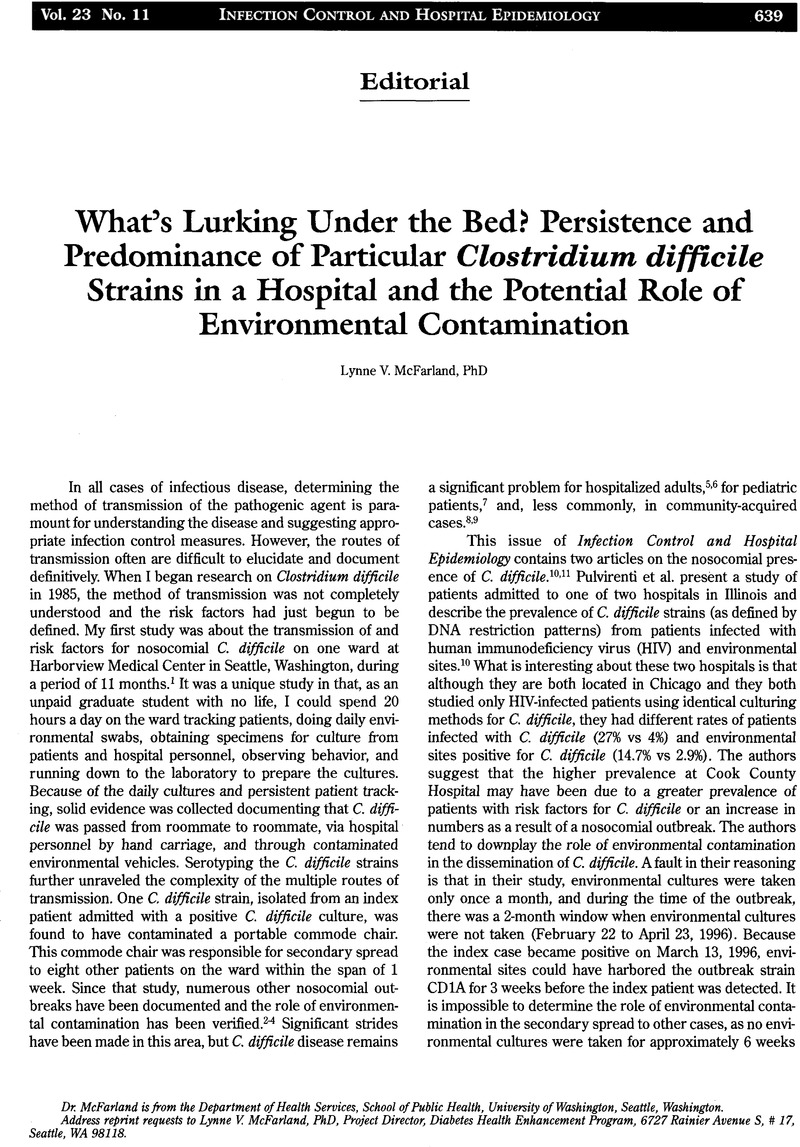Crossref Citations
This article has been cited by the following publications. This list is generated based on data provided by Crossref.
McDonald, L. Clifford
2005.
Clostridium difficile: Responding to a New Threat From an Old Enemy.
Infection Control & Hospital Epidemiology,
Vol. 26,
Issue. 8,
p.
672.
Lawrence, Steven J.
Puzniak, Laura A.
Shadel, Brooke N.
Gillespie, Kathleen N.
Kollef, Marin H.
and
Mundy, Linda M.
2007.
Clostridium difficile in the Intensive Care Unit: Epidemiology, Costs, and Colonization Pressure.
Infection Control & Hospital Epidemiology,
Vol. 28,
Issue. 2,
p.
123.
Whitaker, Jacqueline
Brown, B. Susan
Vidal, Sue
and
Calcaterra, Maria
2007.
Designing a protocol that eliminates Clostridium difficile: A collaborative venture.
American Journal of Infection Control,
Vol. 35,
Issue. 5,
p.
310.
2008.
Infection Prevention and Control.
p.
279.
Arteaga, Alejandro
Santa-Olalla, Patricia
Sierra, M. José
Limia, Aurora
Cortés, Marta
and
Amela, Carmen
2009.
Riesgo epidémico de la enfermedad asociada a una nueva cepa de Clostridium difficile.
Enfermedades Infecciosas y Microbiología Clínica,
Vol. 27,
Issue. 5,
p.
278.
Jöbstl, M.
Heuberger, S.
Indra, A.
Nepf, R.
Köfer, J.
and
Wagner, M.
2010.
Clostridium difficile in raw products of animal origin.
International Journal of Food Microbiology,
Vol. 138,
Issue. 1-2,
p.
172.
Mallozzi, Michael
Viswanathan, VK
and
Vedantam, Gayatri
2010.
Spore-forming Bacilli and Clostridia in human disease.
Future Microbiology,
Vol. 5,
Issue. 7,
p.
1109.
Tenover, Fred C.
Novak-Weekley, Susan
Woods, Christopher W.
Peterson, Lance R.
Davis, Thomas
Schreckenberger, Paul
Fang, Ferric C.
Dascal, Andre
Gerding, Dale N.
Nomura, Jim H.
Goering, Richard V.
Akerlund, Thomas
Weissfeld, Alice S.
Baron, Ellen Jo
Wong, Edith
Marlowe, Elizabeth M.
Whitmore, Joseph
and
Persing, David H.
2010.
Impact of Strain Type on Detection of Toxigenic
Clostridium difficile:
Comparison of Molecular Diagnostic and Enzyme Immunoassay Approaches
.
Journal of Clinical Microbiology,
Vol. 48,
Issue. 10,
p.
3719.
Tenover, Fred C.
Baron, Ellen Jo
Peterson, Lance R.
and
Persing, David H.
2011.
Laboratory Diagnosis of Clostridium difficile Infection.
The Journal of Molecular Diagnostics,
Vol. 13,
Issue. 6,
p.
573.
Doron, Shira I.
Kifuji, Kayoko
Hynes, Brooke Tyson
Dunlop, Dan
Lemon, Tricia
Hansjosten, Karen
Cheng, Teresa
Curley, Barbara
Snydman, David R.
and
Fairchild, David G.
2011.
A Multifaceted Approach to Education, Observation, and Feedback in a Successful Hand Hygiene Campaign.
The Joint Commission Journal on Quality and Patient Safety,
Vol. 37,
Issue. 1,
p.
3.
Saad, Nagah Mohammed
Amin, Wallaa Farouk
and
Shaker, Eman Mokhtar
2013.
Detection of toxigenic Clostridium difficile in powdered infant and follow-up formulae in Egypt.
Veterinary World,
Vol. 6,
Issue. 11,
p.
862.
Wilson, A.P.R.
and
Moore, G.
2014.
Decontamination in Hospitals and Healthcare.
p.
461.
Best, E.L.
Parnell, P.
Thirkell, G.
Verity, P.
Copland, M.
Else, P.
Denton, M.
Hobson, R.P.
and
Wilcox, M.H.
2014.
Effectiveness of deep cleaning followed by hydrogen peroxide decontamination during high Clostridium difficile infection incidence.
Journal of Hospital Infection,
Vol. 87,
Issue. 1,
p.
25.
Nagaraja, Aarathi
Visintainer, Paul
Haas, Janet P.
Menz, Jonathan
Wormser, Gary P.
and
Montecalvo, Marisa A.
2015.
Clostridium difficile infections before and during use of ultraviolet disinfection.
American Journal of Infection Control,
Vol. 43,
Issue. 9,
p.
940.
McFarland, Lynne V.
2017.
Primary prevention of Clostridium difficile infections – how difficult can it be?.
Expert Review of Gastroenterology & Hepatology,
Vol. 11,
Issue. 6,
p.
507.
McFarland, L.V.
Ship, N.
Auclair, J.
and
Millette, M.
2018.
Primary prevention of Clostridium difficile infections with a specific probiotic combining Lactobacillus acidophilus, L. casei, and L. rhamnosus strains: assessing the evidence.
Journal of Hospital Infection,
Vol. 99,
Issue. 4,
p.
443.



